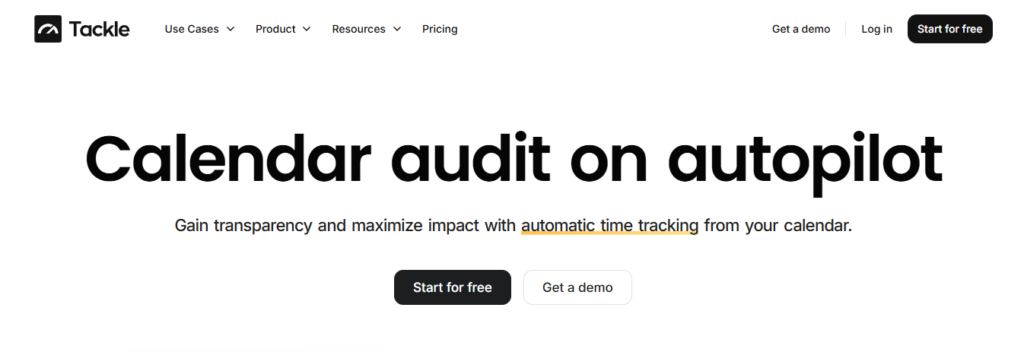Imagine your team is working to manage a project with a tight deadline. You have multiple moving parts to keep track of, and team members are relying on you to keep the project organized and on schedule. Suddenly, you realize you don’t have a solid plan for managing the project’s timeline and keeping everyone on track. That’s where project time management becomes essential—it helps you allocate time effectively, set realistic deadlines, and track progress across tasks. The only problem? There are dozens of options to choose from, including Monday and Asana. So, how do you pick the right one for your team? This article will help you answer that question by outlining the similarities and differences between Monday and Asana so you can find the best project management software for your team.
Tackle’s automatic time tracking software can help you get organized before you even start using a project management tool. By tracking the time you and your team spend on various tasks and projects, you can gain a deeper understanding of your workflow, identify areas for improvement, and establish a baseline for future projects.
Monday vs. Asana at a Glance

While both Asana and monday.com are powerful project management platforms, they excel in slightly different areas depending on team needs and workflows.
Asana’s Robust Task and Workflow Management
Asana stands out when it comes to structured task and workflow management. It’s particularly well-suited for teams that rely heavily on detailed to-do lists, dependencies, and cross-functional collaboration. Its strength lies in automation rules, the ability to build recurring tasks, and deep integrations with tools like:
- Slack
- Google Workspace
- Salesforce
This makes it ideal for marketing teams, agencies, and operations groups that thrive on clarity and repeatable processes.
Customization and High-Level Tracking
Monday.com, on the other hand, is built for customisation, data visualisation, and high-level tracking. It enables teams to create dashboards tailored to specific:
- Performance metrics
- Project timelines
- Team capacity
Visual Data Management and Reporting
Monday’s visual boards, time tracking widgets, and flexible columns make it easier to view large volumes of data at a glance. This makes it a strong choice for departments such as IT, product development, or project management offices that require granular control over data and robust reporting features.
Support-wise, monday.com offers a robust library of customer support options, including tutorials, forums, and 24/7 help, depending on your plan. In contrast, Asana’s support is more tiered and less responsive at the lower pricing levels.
Workflow vs. Visibility
In short, Asana is better for managing individual tasks and team workflows, while Monday.com offers more when it comes to big-picture planning, analytics, and support. The best choice depends on whether your team values workflow automation or performance visibility more.
Related Reading
- Is Time Tracking Effective
- How to Keep Track of Projects at Work
- Project Delivery Management
- Time Tracking Best Practices
- Project Progress Tracking
What is Monday.com?

Monday.com is a cloud-based project and work management platform designed for planning and managing projects, as well as tracking day-to-day workplace activities, tasks, and responsibilities. As tools for project management go, it’s extremely easy to use, with a clean interface, helpful instructions, and intuitive tools that don’t take long to master.
Advanced Project Monitoring and Data Visualization
It features advanced tools, including a workload view to monitor project progress and team tasks, as well as one of the best dashboard builders, earning a 5/5 rating for data visualization. Thanks to its customizability, monday.com suits various teams, from those needing a central platform for daily tasks to larger teams aiming to streamline processes at scale.
Intuitive Kanban and Automation
Monday.com’s Kanban board was easy to use, allowing me to view our task lists at a glance. Its cards are fully customizable. Monday.com has a straightforward automation builder that is easier to use than most, and a genuinely helpful and highly responsive live chat function for identifying where you’ve gone wrong.
There’s also a handy, customizable “Chart” area for project insights, as well as a Kanban board, a time-tracking feature, and a classic grid or table view.
Key Features
Monday.com has many features for tracking time and managing project schedules. These include:
- Time tracking: Track hours for any task with a simple timer.
- Task scheduling: Schedule tasks for specific days or hours and view upcoming work on a calendar.
- Resource allocation: Visualize employees’ workloads to determine how to allocate new work effectively.
- Automations: Automatically assign tasks to employees based on their workloads.
- Integrations: 200+ integrations enable you to create timesheets and utilize your time-tracking data for invoicing and payroll purposes.
What is Asana?

Asana is one of the best project management software options on the market, offering various views that support both traditional project management methodologies and Agile frameworks. The views can be tailored to all team members involved, making it easy to customize Asana to suit the project you’re working on.
Comprehensive Free Plan Features
The free version, which supports up to 10 members, offers a range of capabilities to make your life easier. You’ll have unlimited storage, tasks, assignees, due dates, and messages, and you can look up records of past projects. The free plan also supports:
- Integrations
- Lists
- Kanban boards
- Calendar views
Scalability and Advanced Features
If you have a small team, the free version can be a great long-term solution. Outside of the free plan, Asana offers Gantt charts and workload views, goals, and portfolios. Being able to switch between these views gives more flexibility to your team members and makes sharing data with stakeholders easier.
Automation and Integrations
Additionally, Asana supports various automatic processes and integrations that can make your team more efficient. You can create automated workflows across many platforms, including Slack, Microsoft Teams, Google Drive, and others. Overall, Asana is powerful software that will serve many teams well.
Tackle: Automatic Time Tracking Software You Can Trust
Tackle revolutionizes time tracking through seamless calendar integration, eliminating the need for manual logging. Our platform automatically captures and categorizes your time, providing actionable insights through intuitive dashboards and reports. We’ve built everything you need into one seamless package:
- An intelligent tagging system that works your way
- AI-powered automation to handle the tedious stuff
- Flexible reporting tools to track what matters
- Intelligent time capture right in your browser
Time Optimization for Professionals
Trusted by teams at Roblox, Deel, and Lightspeed Ventures, Tackle helps executives, team leaders, and customer-facing professionals understand and optimize their time allocation. Simply connect your Google or Outlook calendar, set up custom tags and automations, and gain valuable insights into how your team spends their time.
Tackle’s Impact on Decision-Making
Whether you’re tracking strategic initiatives, measuring team efficiency, or optimizing resources, Tackle transforms time monitoring from a chore into a powerful decision-making tool.
Start using our automatic time tracking software for free with one click today!
Related Reading
- Client Project Management
- Best Project Management Software for Creative Agency
- Agency Resource Management Software
- Best Agency Project Management Software
- Monday.com vs Basecamp
- Monday.com vs Jira
- Creative Agency Resource Management
Monday vs. Asana: Key Features Comparison

Asana is built around structured task and workflow management. Tasks can be created, assigned, and tracked using multiple views, including list, board, calendar, and timeline. It shines with its Work Graph model, providing teams with real-time visibility into who is doing what and by when.
Workflow Automation and Visualizations
Workflow automation features, such as rules and custom templates, enable users to build repeatable processes in minutes. Monday.com refers to tasks as “pulses” and offers a similarly robust foundation in task creation, assignment, and tracking. Nevertheless, monday.com leans heavily into visualisation, offering views like:
- Gantt
- Calendar
- Timeline
- Per-member Workload
This makes it a solid choice for teams that want a dynamic overview of how work is progressing across the organisation.
Collaboration: Asana vs. Monday.com
Asana Flow promotes collaboration by connecting tasks, teams, and tools. With features like Workflow Builder, you can design custom flows that connect work across departments, offering end-to-end visibility and clarity. Monday.com enables collaboration through:
- Customisable templates
- Document sharing
- Integrations with communication tools
It provides flexible templates for team tasks, meetings, and campaigns, while also supporting in-platform chat, file sharing, and video conferencing integration, making it more robust in real-time collaboration environments.
Time Tracking: Asana vs. Monday.com
Monday.com includes a native time tracking column, simply hit ‘start’ when working and ‘stop’ when finished. This is useful for teams who bill by the hour or want insight into how time is spent across tasks. Asana does not include built-in time tracking. Instead, it integrates with third-party time tracking apps. While effective, it requires setup and sometimes an additional subscription.
File Management: Asana vs. Monday.com
Monday.com allows file uploads directly within tasks and integrates file storage into its workflows. This makes it easier for teams to share, comment on, and collaborate on documents all in one place. Asana supports file sharing through tasks but lacks a dedicated file management system.
Users often rely on integrations with platforms like Google Drive, Dropbox, and Box to organize files.
Notes: Asana vs. Monday.com
Monday.com offers structured meeting notes templates that teams can adapt for planning and documentation. These templates help standardize communication and keep records organized. Asana supports note-taking within tasks and projects, but the functionality isn’t as structured or centralized. Notes are often scattered unless teams follow strict naming or tagging conventions.
Ease of Use: Asana vs. Monday.com
Asana is widely praised for its clean and intuitive UI. Navigation is smooth, and its learning curve is relatively short, especially for users familiar with to-do lists and project workflows. Monday.com is also user-friendly but can feel more complex due to its visual structure and flexibility. New users may require onboarding or some practice before fully leveraging its capabilities.
Customer Support: Asana vs. Monday.com
Monday.com offers 24/7 support via email, chat, forums, and a comprehensive knowledge base. Higher-tier plans often receive priority support and account management. Asana does not offer phone support and prioritizes support access based on plan level. Email and live chat are available, alongside an extensive help centre and community forum.
Pricing: Asana vs. Monday.com
Asana is ideal for growing teams, offering a generous free plan for up to 10 users, as well as premium features like timeline view and custom rules on its paid plans.
- Personal: Free forever
- Starter: $10.99/user/month (annual)
- Advanced: $24.99/user/month (annual)
- Enterprise & Enterprise+: Custom pricing. Monday.com also offers a free plan, although it is limited to 2 users and lacks core features such as integrations and automations. Paid tiers add functionality but may require careful consideration to match budget and team size.
- Free: 2 seats, limited features
- Basic: $9/seat/month (annual)
- Standard: $12/seat/month (annual)
- Pro: $19/seat/month (annual)
- Enterprise: Custom pricing
What Users Say: Asana vs. Monday.com
On platforms like Reddit, Asana is frequently praised for its structured interface, ease of use, and strong reporting capabilities, especially for teams managing complex workflows and dependencies. Monday.com receives positive feedback for its flexibility and visual appeal, but requires some upfront learning.
Some users appreciate its ability to assign multiple stakeholders to a single task, while others note that this can lead to blurred accountability if not carefully managed.
10 Benefits of Project Management Software for Business

1. Effortless Project Planning
Project management software streamlines the planning process by providing tools such as task lists, timelines, and Gantt charts. These features enable you to:
- Visually map out each project step
- Assign tasks
- Set deadlines
- Ensure that the team is clear on what needs to be done and when
This structured approach helps prevent confusion and delays, ensuring everyone stays on the same page.
2. Balance Resource Management
Resource management software is the key to a successful project. It helps you allocate resources efficiently, ensuring you don’t overburden team members or leave critical tasks understaffed. It tracks resource usage in real-time, allowing you to adjust as necessary, ensuring that people, time, and budget are distributed optimally for maximum efficiency.
3. Pipeline Forecasting
Pipeline forecasting enables companies to anticipate project needs and allocate resources proactively. Project management software provides insight into:
- Upcoming projects
- Tasks
- Deadlines
This helps you forecast workloads, identify potential bottlenecks, and make data-driven decisions about future resource needs. This ability to plan reduces uncertainty and ensures your team is prepared for upcoming demands.
4. Align the Team to Strategic Priorities
Project management software ensures that everyone on the team is aligned with the company’s strategic goals. By linking tasks and milestones to broader organizational objectives, project managers can guide their teams to focus on what truly matters. This alignment:
- Helps prevent distractions
- Boosts productivity
- Ensures that all efforts are contributing to the company’s long-term success.
5. Pivot Priorities
In the fast-paced world of business, priorities can shift quickly. Project management software allows you to adapt to these changes easily. When something urgent arises or the focus of a project needs to move, you can:
- Adjust timelines
- Reassign resources
- Notify the team in real-time
This flexibility enables teams to stay agile and respond to changes without losing sight of their overall goals.
6. Improves Team Collaboration
Collaboration is at the heart of successful project management. Project management software provides a centralized platform for team members to communicate, share files, comment on tasks, and track progress. This helps eliminate confusion caused by scattered communication channels, keeping everyone informed and fostering a more collaborative work environment.
7. Improves Remote Work
Remote work is increasingly common, and project management software bridges the gap between team members working from different locations. With cloud-based tools, teams can:
- Access project information
- Collaborate
- Track progress from anywhere
This enhances productivity and ensures that remote teams can operate as effectively as in-house teams, without the need for constant meetings or follow-ups.
8. Effective Internal & External Communication
Good communication is crucial for the success of any project. Project management software ensures that both internal team communication and external client communication are clear and consistent. You can:
- Share updates
- Request feedback
- Resolve issues quickly
This streamlined communication ensures that both your team and stakeholders are always on the same page, reducing misunderstandings and keeping the project on track.
9. Leveraging Employee Skills and Strengths
Many project management tools incorporate skills mapping into their resource management functionality. This is extremely helpful because not only can you better assign work based on people’s skill sets, but you also give employees the chance to self-identify their strengths.
According to Gallup, simply learning about their strengths makes employees 7.8% more productive, and teams that focus on strengths every day have 12.5% greater productivity.
10. Improving Data Access
Making project data more accessible to all team members is crucial for effective project management. Say goodbye to time wasted digging through email threads and looking inside every folder for the missing piece of information, all while trying to juggle your tasks.
And this time does add up—respondents to a McKinsey study reported that 30% of total enterprise time is spent on non-value-added tasks due to poor data quality and availability.
The Cost of Information Retrieval
Nevertheless, not everyone works at an enterprise level. Let’s run some quick math to illustrate this point simply: After time tracking, an employee has 40 hours logged on their timesheet for a week. They have spent 10 minutes a day looking around for the information they need. That totals up to 50 minutes a week, or 43+ hours a year, trying to find what they need.
Related Reading
- Microsoft Project vs Trello
- Monday.com Competitors
- Jira vs Basecamp
- Basecamp Competitors
- Bonsai Alternatives
- Asana Alternative
- Trello Alternative
Start Using Our Automatic Time Tracking Software for Free with One Click Today

Forget about clunky time tracking tools that waste more time than they save. Tackle revolutionizes time tracking through seamless calendar integration, eliminating the need for manual logging. Our platform automatically captures and categorizes your time, providing actionable insights through intuitive dashboards and reports. We’ve built everything you need into one seamless package:
- An innovative tagging system that works its way
- AI-powered automation to handle the tedious stuff
- Flexible reporting tools to track what matters
- Intelligent time capture right in your browser
Optimize Time with Tackle
Trusted by teams at Roblox, Deel, and Lightspeed Ventures, Tackle helps executives, team leaders, and customer-facing professionals understand and optimize their time allocation. Simply connect your Google or Outlook calendar, set up custom tags and automations, and gain valuable insights into how your team spends their time.
Time Tracking for Strategic Decisions
Whether you’re tracking strategic initiatives, measuring team efficiency, or optimizing resources, Tackle transforms time monitoring from a chore into a powerful decision-making tool.
Start using our automatic time tracking software for free with one click today!



